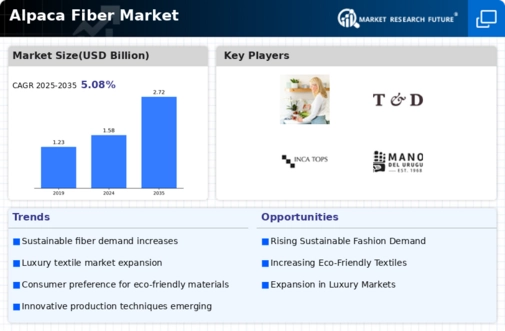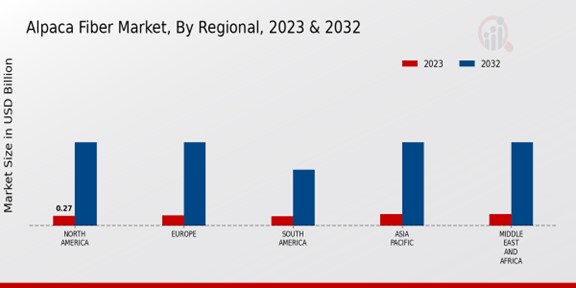Market Trends and Projections
The Global Alpaca Fiber Market Industry is projected to grow significantly, with estimates indicating a market value of 1.58 USD Billion in 2024 and a potential increase to 2.72 USD Billion by 2035. The compound annual growth rate of 5.07% from 2025 to 2035 suggests a robust expansion trajectory. This growth is influenced by various factors, including rising consumer demand for sustainable textiles, technological advancements in fiber processing, and the increasing popularity of luxury fashion. The market's evolution reflects broader trends in consumer preferences and industry practices, positioning alpaca fiber as a key player in the global textile landscape.
Expansion of E-commerce Platforms
The Global Alpaca Fiber Market Industry is experiencing growth due to the expansion of e-commerce platforms, which facilitate access to alpaca fiber products for consumers worldwide. Online retailing allows for a broader reach, enabling small producers and artisans to showcase their alpaca fiber goods to a global audience. This trend is particularly significant in regions where traditional retail options are limited. The convenience of online shopping, combined with the rising interest in unique and sustainable products, is likely to enhance sales in the Global Alpaca Fiber Market Industry. As e-commerce continues to evolve, it may further drive the growth of alpaca fiber's market presence.
Growing Popularity of Luxury Fashion
The Global Alpaca Fiber Market Industry benefits from the growing popularity of luxury fashion, where alpaca fiber is increasingly recognized for its softness and warmth. High-end brands are incorporating alpaca into their collections, appealing to consumers seeking premium quality. This trend is particularly pronounced in regions with colder climates, where the insulating properties of alpaca fiber are highly valued. As the luxury fashion segment continues to expand, the market for alpaca fiber is projected to grow significantly, contributing to the anticipated increase to 2.72 USD Billion by 2035. This shift indicates a robust opportunity for producers and retailers within the Global Alpaca Fiber Market Industry.
Rising Demand for Sustainable Textiles
The Global Alpaca Fiber Market Industry experiences a surge in demand for sustainable textiles, driven by increasing consumer awareness regarding environmental issues. Alpaca fiber, known for its eco-friendly properties, offers a biodegradable alternative to synthetic fibers. As consumers prioritize sustainability, the market is projected to reach 1.58 USD Billion in 2024. This shift towards sustainable fashion is further supported by various initiatives aimed at promoting ethical sourcing and production practices. Consequently, brands incorporating alpaca fiber into their collections are likely to gain a competitive edge, thereby propelling the growth of the Global Alpaca Fiber Market Industry.
Health Benefits Associated with Alpaca Fiber
The Global Alpaca Fiber Market Industry is influenced by the health benefits associated with alpaca fiber, which is hypoallergenic and contains no lanolin. This characteristic makes it an appealing choice for consumers with sensitive skin or allergies. As awareness of these health benefits spreads, more consumers are likely to choose alpaca fiber products over traditional wool or synthetic alternatives. The growing interest in wellness and comfort in textiles is expected to drive demand, further solidifying the position of alpaca fiber in the market. This trend may lead to increased production and innovation within the Global Alpaca Fiber Market Industry.
Technological Advancements in Fiber Processing
Technological innovations in fiber processing are transforming the Global Alpaca Fiber Market Industry. Advanced spinning and weaving techniques enhance the quality and versatility of alpaca fiber, making it suitable for a broader range of applications, including high-end fashion and home textiles. These advancements not only improve the efficiency of production but also reduce waste, aligning with sustainability goals. As a result, the market is expected to witness a compound annual growth rate of 5.07% from 2025 to 2035. The integration of technology in processing alpaca fiber may lead to increased product offerings, attracting diverse consumer segments and expanding the market.






